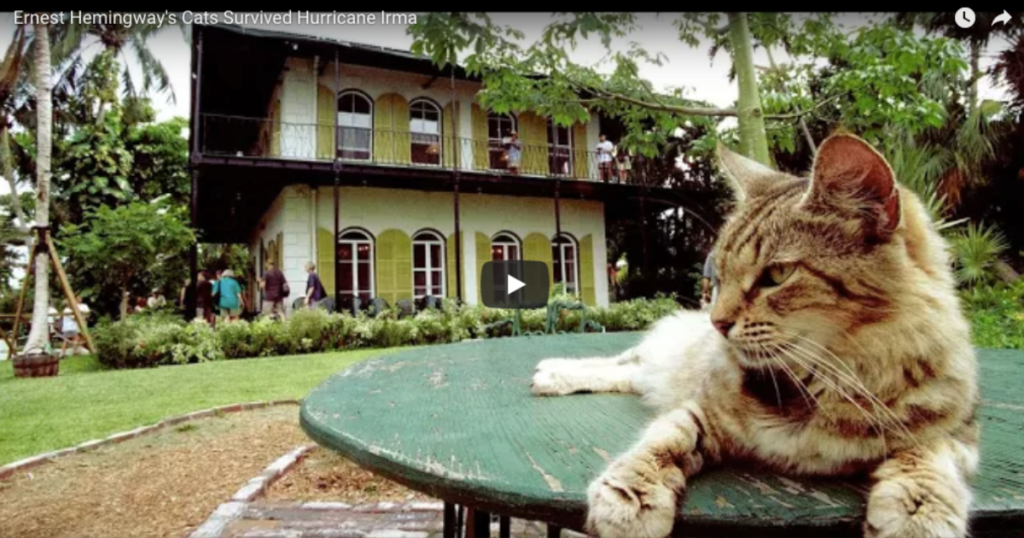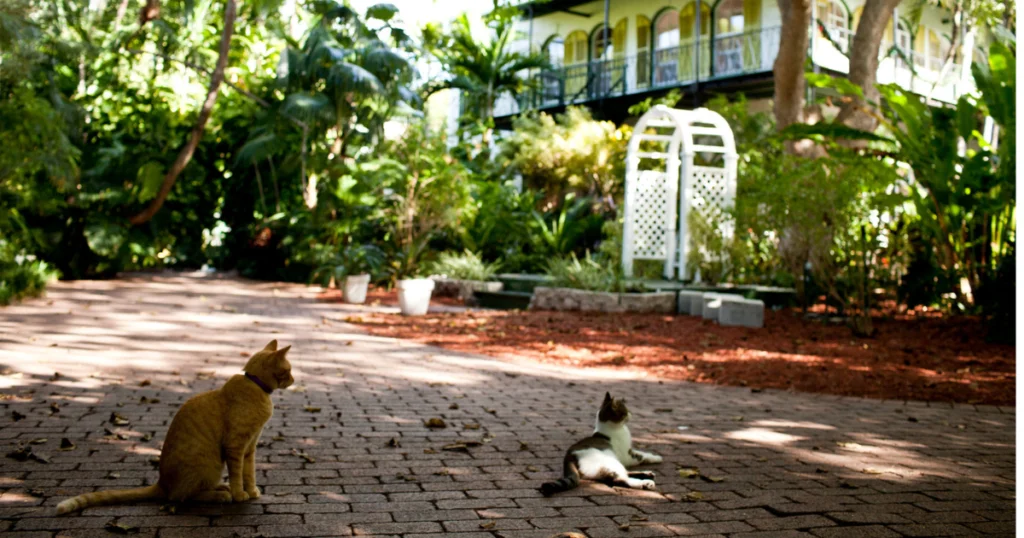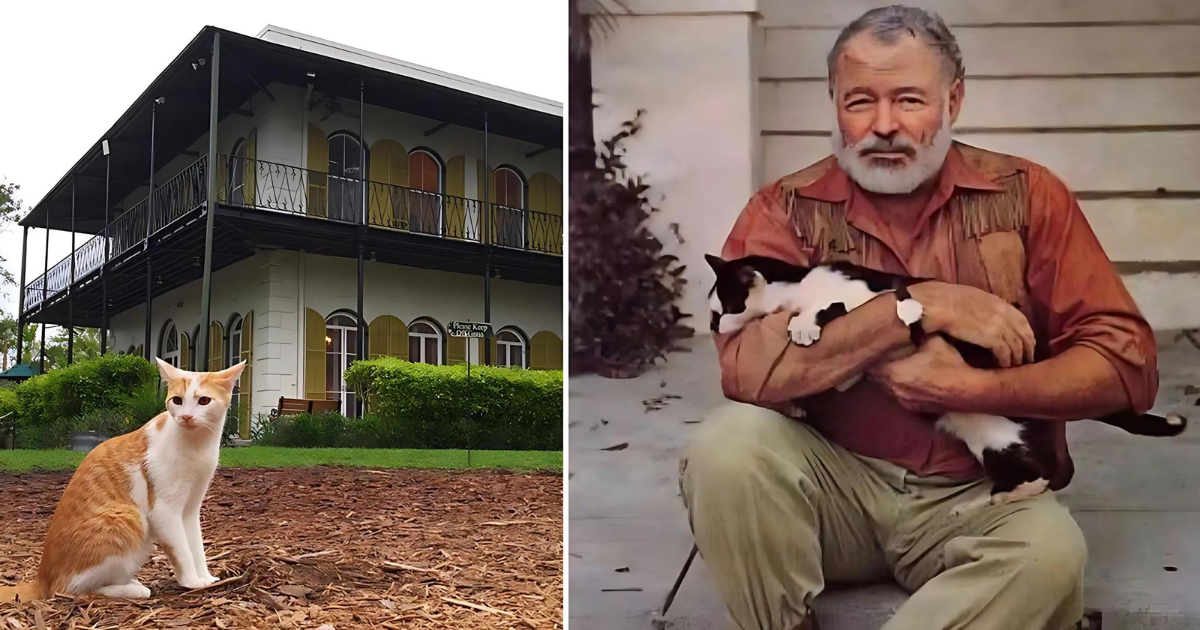Hemingway Cats, renowned for his literary prowess and love for cats, maintained a colony of felines at his Key West home, many of which were polydactyl, meaning they had extra toes. These cats, affectionately known as Hemingway’s six-toed cats, have become a beloved attraction at the Ernest Hemingway Home and Museum. Visitors can observe these unique cats up close and learn about their fascinating history.
During his time in Key West, Hemingway penned several of his most famous works, including “A Farewell to Arms,” “To Have and Have Not,” and “The Snows of Kilimanjaro.” He wrote in a small studio on the property, surrounded by the cats he cherished. Visitors can explore the studio and gain insights into the writing process of one of America’s most celebrated authors.
Read More: Caring for Your Cat in 2024

A Cat Named Snow White
One of the most intriguing aspects of Hemingway’s six-toed cats is their lineage. All are descendants of a cat named Snow White, a gift from a ship’s captain to Hemingway in the 1930s. The Ernest Hemingway Home and Museum is home to approximately 60 polydactyl cats, with about half displaying the physical trait of extra toes. However, all carry the polydactyl gene in their DNA, meaning even cats with four or five toes can produce six-toed kittens. The museum staff shares stories about the cats’ personalities and their role in the house.
Hemingway named all of his cats after famous people, a tradition that continues today at the museum. The cats are capable of learning and responding to their names, particularly if they have an affectionate relationship with the person who calls them.
Many tourists visit the museum specifically to see the cats, making one wonder if the cats are as popular, or even more so, than Hemingway himself.
When visiting the Ernest Hemingway Home and Museum, be sure to stroll through the lush gardens and see the cats lounging in the sun, or perhaps even catch a glimpse of them napping in one of Hemingway’s favorite spots on the property. The museum is open 365 days a year, from 9 am to 5 pm, and is located at 907 Whitehead Street, Key West, FL 33040. Learn more about Hemingway and his famous cats here. (Photos courtesy of Hemingway Home Museum on Facebook.)
2024 Hemingway Days Festival
Ernest Hemingway enthusiasts and those inspired by his literary accomplishments and adventurous lifestyle, including many with beards resembling his own, will gather in Key West from July 18-23 for Hemingway Days 2024.
If you are a literary buff, you may have heard about Ernest Hemingway’s adoration of cats, so much so that a specific breed has even been named after the author.
Hemingway cats, or more accurately, polydactyl cats, are known for their extra toes. How did this come to be, and what is the real story behind Hemingway cats?
The team at Shiloh Veterinary Hospital sets out to solve this mystery and explain why these unusual 6-toed cats evolved.
What Is a Polydactyl Cat?
The term polydactyly means many toes. This is caused by a genetic trait that occurs in certain felines whose parents passed this trait down through their lineage. This dominant gene can produce up to seven toes on each paw. It is typically seen on the front paws, but all four feet can be affected.
What’s the Story Behind the Hemingway Cats Family?
Ernest Hemingway received a cat named Snow White in the 1930s. This kitten was unique because she had six toes on her front paws. This sweetie was a gift from a sailing captain named Stanley Dexter, a colleague of Hemingway’s who, along with cats, loved the sea.
Among sailors, 6-toed cats (sometimes called mitten cats) are viewed as good luck and are considered better hunters aboard the ship.
The Hemingway homestead in Key West, FL is still the home to roughly 45 descendants of Snow White and her brood.
The Things That Make 6-Toed Cats Special
Along with their unique quality of having additional toes, there are some other notable things about these special cats that endear them to many.
- Better Athletes: Their toes allow them to be better athletes. From gripping things to climbing and hunting, some of these cats are benefited by their extra digits. In some cases, they are better able to balance on certain surfaces, as well as traipse through snow with their wide paws.
- Considered Lucky: Because they are thought to be better mousers than non-polydactyl cats, they are considered a boon for many households and farms. This thought is still widely held in Great Britain, Wales, Canada, and the East Coast of the United States.
- Loved by Maine Coon Fans: For several generations, up to 40% of Maine Coon cats had these extra toes. Since then, the percentage has given way to a genetic trait of wider paws, without the extra digits. Still, aficionados of this breed have come to look for and cherish this special quality of multi-digits in their favored felines.
- Great Conversation Starter: Many pet lovers like to brag about their adorable pets, and it’s exciting to talk about what’s unusual about them. For cat fanciers, these mitten friends are a subject of conversation, and they even have Facebook fan pages devoted to them.
It’s interesting to note that, according to the Guinness Book of World Records, a ginger tabby named Jake has held the record for the most number of toes: 28, or 7 per each paw.
No matter if your pet is a polydactyl or not, we’re sure they are unique in their own special way. If you would like more information on 6-toed cats, or would like to schedule an appointment, please contact us.
Ernest Hemingway (1866-1961), Pulitzer Prize and Nobel Prize-winning author, journalist, man’s man, war correspondent, safari-taker, world traveler was a self-proclaimed cat lover. Hemingway was proud of his cat collection, often saying that he liked nothing better than the feeling of having cats underfoot. Calling them his “purr factories” and claiming that “one cat just leads to another,” the author once owned over 50 cats while living at his famous house, the Finca Vigia in Cuba.
Visitors to his home would tell stories of kittens in the beds and the dinner table swarming with cats; “no animal has more liberty than the cat,” Hemingway wrote observantly in For Whom the Bell Tolls and the author certainly put this into practice as his many cats evidently enjoyed free reign over every room of the house.
Initially keeping a spare bedroom as a specially designated cat room, eventually Hemingway had to cede his entire house over to his freely roaming feline companions as their population grew, feeding them generously from “cases of salmon” and drinking with them in the evenings, offering them a mixture of whiskey and milk. It was in Cuba that he began to collect polydactyl (multi-toed) cats; along with the local sailors, he considered them to be good luck.
Once when living in a grotto in Paris as a young man, Hemingway decried that he was “too poor to even own a cat.” With his low voice and gentle manners, Hemingway had a way with animals in general, often seeking help for strays and injured animals. His favorite cat, a black and white tom called Boise, was immortalized as a character in Hemingway’s novel Islands in the Stream. With names like Princess Six-Toes, Feather Puss, Zane Grey, Clark Gable, Uncle Wolfer, Furhouse, Christobal, and Good Will, Hemingway believed in the individuality of each of his pets, professing a deep regard for what he called the “absolute emotional honesty” of cats.
Today the Hemingway House Museum in Key West, Florida, where the author lived in the 1930s, is home to over 40 cats, notoriously the polydactyl cats that have become synonymous with Ernest Hemingway. To this day, the museum claims that its cats are the actual descendants of Hemingway’s original white multi-toed cat, Snowball. As in the author’s lifetime, the cats roam freely and are protected there, safely cared for per the terms of Hemingway’s will.
The Hemingway House Museum is open and welcoming to visitors, as are the cats. While the rooms of the house are restricted to public access, the cats are not hindered by “Do Not Touch” signs and velvet ropes; the creatures that he so adoringly called his “love sponges” still sleep on Hemingway’s bed, lounge on his writing desk, and wander the gardens at ease.
Hemingway Cats for Sale
While the Ernest Hemingway Home and Museum in Key West, Florida, is home to a colony of Hemingway Cats, these cats are not typically available for sale. The museum takes great care to ensure the well-being and protection of these cats, which are considered part of the historical site. However, polydactyl cats, which are the same breed as Hemingway Cats, can be found for adoption or purchase through reputable breeders and rescue organizations.

Ernest Hemingway Cats Names
Ernest Hemingway had a tradition of naming his cats after famous people, a practice that continues at the museum today. Some of the notable names include:
- Snow White: The original polydactyl cat given to Hemingway by a ship’s captain.
- Princess Six-Toes
- Feather Puss
- Zane Grey
- Clark Gable
- Uncle Wolfer
- Furhouse
- Christobal
- Good Will
These names reflect Hemingway’s appreciation for the individual personalities and quirks of each cat.
Hemingway Cats Price
The price of a polydactyl cat can vary depending on the breeder, the cat’s lineage, and its specific traits. Generally, polydactyl cats can range from $500 to $2,000 or more. It’s important to adopt or purchase from reputable sources to ensure the cat’s health and well-being.
Hemingway Cats Personality
Hemingway Cats are known for their unique personalities, which can vary greatly from one cat to another. Generally, they are:
- Affectionate: Many Hemingway Cats enjoy human interaction and can be quite cuddly.
- Independent: Like most cats, they also value their independence and personal space.
- Playful: These cats often exhibit high levels of energy and enjoy playing with toys and interacting with their environment.
- Intelligent: Hemingway Cats are known for their intelligence and ability to learn and respond to their names.
Hemingway Cats Photos
Photos of Hemingway Cats often showcase their unique physical traits, particularly their extra toes. These cats can be found lounging in the sun, exploring the gardens, or even napping in Hemingway’s favorite spots at the museum. The Ernest Hemingway Home and Museum’s Facebook page is a great resource for photos of these charming felines.
Why Are They Called Hemingway Cats?
Hemingway Cats are named after Ernest Hemingway because of his deep affection for these polydactyl cats. He kept a colony of them at his home in Key West, and their descendants continue to reside at the museum today. The term “Hemingway Cats” has become synonymous with polydactyl cats due to his love for them.
Cats with 6 Toes Hemingway
Polydactyl cats, often referred to as “six-toed cats,” are known for having extra toes on their paws. This genetic trait can result in up to seven toes on each paw, although it is typically seen on the front paws. These extra toes can provide benefits such as improved gripping, climbing, and hunting abilities.
Hemingway Cats Breeds
Hemingway Cats are not a specific breed but rather a group of polydactyl cats with a unique history tied to Ernest Hemingway. Polydactyly can occur in various cat breeds, including Maine Coons, which were once known for their high percentage of polydactyl individuals.
Conclusion:
Hemingway Cats are a fascinating and beloved part of Ernest Hemingway’s legacy. Their unique physical traits, charming personalities, and rich history make them a subject of interest for cat lovers and literary enthusiasts alike. While they are not typically available for sale, polydactyl cats can be found through reputable breeders and rescue organizations. For those interested in learning more about these extraordinary felines, a visit to the Ernest Hemingway Home and Museum in Key West is a must.
For more information and to explore the world of Hemingway Cats, visit the Ernest Hemingway Home and Museum or contact reputable breeders and rescue organizations.
FAQs:
What are Hemingway Cats?
Hemingway Cats are polydactyl cats, known for having extra toes. They are named after Ernest Hemingway, who kept a colony of these cats at his home in Key West.
Why are they called Hemingway Cats?
They are called Hemingway Cats because Ernest Hemingway had a particular fondness for these polydactyl cats and kept many of them at his home.
What is polydactyly?

Polydactyly is a genetic trait that results in extra toes on a cat’s paws. It can affect one or more paws and is often seen on the front paws.
Where did Hemingway’s six-toed cats originate?
Hemingway’s six-toed cats are descendants of a cat named Snow White, a gift from a ship’s captain to Hemingway in the 1930s.
How many Hemingway Cats are there at the Ernest Hemingway Home and Museum?
The museum is home to approximately 60 polydactyl cats, with about half displaying the physical trait of extra toes.
Do all Hemingway Cats have extra toes?
Not all Hemingway Cats have extra toes, but they all carry the polydactyl gene, meaning they can produce six-toed kittens.
Why are polydactyl cats considered lucky?
Among sailors, polydactyl cats are viewed as good luck and are considered better hunters aboard the ship.
What is the Hemingway Days Festival?
The Hemingway Days Festival is an annual event in Key West that celebrates Ernest Hemingway’s literary accomplishments and adventurous lifestyle.
Can visitors interact with the Hemingway Cats at the museum?
Yes, visitors can see the cats up close and learn about their history. The cats roam freely and are not hindered by “Do Not Touch” signs.
What are some of the names of Hemingway’s cats?
Hemingway named his cats after famous people, such as Princess Six-Toes, Feather Puss, Zane Grey, Clark Gable, Uncle Wolfer, Furhouse, Christobal, and Good Will.
Why did Hemingway love cats so much?
Hemingway loved the “absolute emotional honesty” of cats and enjoyed their company, often referring to them as his “purr factories.”
How many cats did Hemingway own at his peak?
At his peak, Hemingway owned over 50 cats while living at his famous house, the Finca Vigia in Cuba.
What is the significance of the Hemingway House Museum in Key West?
The Hemingway House Museum is significant because it preserves the legacy of Ernest Hemingway and his love for cats, housing over 40 polydactyl cats that are descendants of his original cats.
Are Hemingway Cats a specific breed?
No, Hemingway Cats are not a specific breed but rather a group of polydactyl cats with a unique history tied to Ernest Hemingway.
How do extra toes benefit Hemingway Cats?
Extra toes can make Hemingway Cats better athletes, improving their gripping, climbing, and hunting abilities. They may also help with balance and traversing certain surfaces.
Are Hemingway Cats more popular than Ernest Hemingway himself?
Many tourists visit the museum specifically to see the cats, making one wonder if the cats are as popular, or even more so, than Hemingway himself.
What is the role of the museum staff in caring for the Hemingway Cats?
The museum staff shares stories about the cats’ personalities and their role in the house, ensuring they are well-cared for and protected.
Can visitors see Hemingway’s writing studio at the museum?
Yes, visitors can explore Hemingway’s writing studio and gain insights into his writing process.
What is the Guinness World Record for the most number of toes on a cat?
According to the Guinness Book of World Records, a ginger tabby named Jake has held the record for the most number of toes: 28, or 7 per each paw.
How can I learn more about Hemingway Cats?
You can learn more about Hemingway Cats by visiting the Ernest Hemingway Home and Museum in Key West, FL, or by exploring resources and articles about them online.










